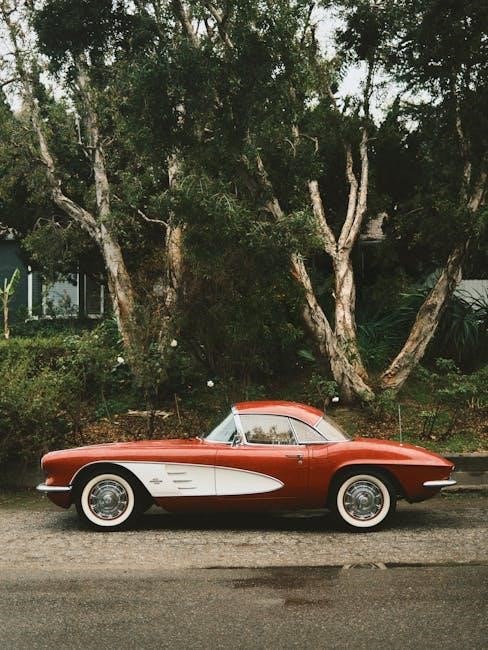The C4 Corvette, produced from 1984 to 1996, offers a blend of performance, style, and affordability, making it a popular choice for collectors and enthusiasts. This guide provides essential insights for buyers, covering key aspects to consider when purchasing and maintaining a C4 Corvette.

History of the C4 Corvette
The C4 Corvette, produced from 1984 to 1996, marked a significant evolution in the Corvette’s legacy. It was designed to modernize the brand while enhancing performance and handling. The C4 debuted in 1984 after a one-year production delay, as Chevrolet refined its design and technology. Notably, there was no official 1983 Corvette model.
During its production run, the C4 introduced several innovations, including a more aerodynamic design, improved suspension systems, and advanced electronics. The L98 V8 engine became a staple, delivering robust power and reliability. In 1989, Chevrolet introduced the ZF 6-speed manual transmission, replacing the earlier Doug Nash 4+3 manual, which had been criticized for its complexity. The C4 also saw the introduction of the ZR-1 model in 1990, featuring the powerful LT5 engine, which further solidified the Corvette’s reputation as a high-performance vehicle.
The C4 Corvette gained recognition for its exceptional handling capabilities, with Chevrolet claiming it could outperform European sports cars like the Porsche 928. Its success in racing and growing sales made it a standout model. Despite initial criticism for its interior and ride quality, the C4 remains a beloved and accessible choice for collectors and enthusiasts today.

Why Buy a C4 Corvette?
The C4 Corvette offers an exceptional blend of performance, style, and affordability, making it a standout choice for car enthusiasts. Produced from 1984 to 1996, the C4 represents a significant leap forward in Corvette’s evolution, with improved handling and modernized design. It is often regarded as one of the best value propositions in the used sports car market, providing a world-class driving experience at a fraction of the cost of newer models.
Key advantages include its powerful V8 engines, advanced suspension systems, and iconic styling that has aged remarkably well. The C4 also offers a range of models, including the high-performance ZR-1, which delivers supercar-like performance at a more accessible price. Additionally, the C4 Corvette has a strong aftermarket support and active enthusiast communities, making it easier to maintain and upgrade.
For those looking to enter the Corvette ownership experience without breaking the bank, the C4 is an excellent choice. Its affordability, combined with its durability and timeless appeal, makes it a practical yet rewarding investment for both new and seasoned collectors.

Overview of C4 Models and Special Editions
The C4 Corvette, produced from 1984 to 1996, offers a diverse range of models and special editions that cater to different driving preferences and collector interests. The base model Corvette Coupe and Convertible were the most common configurations, featuring the L98 V8 engine and a blend of performance and comfort.
For enthusiasts seeking higher performance, the ZR-1 model, introduced in 1990, stands out with its powerful DOHC LT5 engine, delivering 405 horsepower. This model was a significant upgrade, offering supercar-like performance at a more accessible price point. Other notable editions include the 40th Anniversary Corvette in 1993, featuring a unique Ruby Red exterior and interior, and the 1996 Grand Sport, a tribute to the iconic 1963 Grand Sport race cars.
Special editions like the Z07 High-Performance Package and the optional F45 Selective Ride and Handling suspension further enhanced the C4’s capabilities. These variations not only provide buyers with options but also add to the collectibility and value of certain models. Understanding the differences between these models and editions is crucial for making an informed purchase decision.

C4 Corvette Buyer’s Guide
This guide provides essential insights for purchasing a C4 Corvette, covering market value, factors to consider, key inspection areas, common issues, and negotiation tips. It helps buyers make informed decisions and avoid costly mistakes when acquiring a C4 Corvette.
Understanding Market Value
The market value of a C4 Corvette varies based on factors such as condition, rarity, and model year. Well-preserved models typically range from $10,000 to $25,000, while limited editions or high-performance variants like the ZR-1 can command higher prices. The condition of the vehicle plays a significant role, with original, low-mileage cars often fetching premium prices. Additionally, certain model years, such as 1989 and 1996, are more sought after due to performance upgrades and unique features. Buyers should also consider the cost of any needed repairs or upgrades, as these can impact the overall value. It’s important to research recent sales data and consult pricing guides to determine a fair market value for the specific C4 Corvette you’re interested in. This ensures you make an informed decision and avoid overpaying. Understanding the market value is crucial for negotiations and securing a good deal.
Factors to Consider When Purchasing
When purchasing a C4 Corvette, several factors should be carefully considered to ensure you make a well-informed decision. First, evaluate the model year, as later years (1989 and beyond) often feature improvements such as the ZF 6-speed manual transmission and selective ride control. Early models, particularly those with the Doug Nash 4+3 manual transmission, may require closer inspection due to known issues. The condition and originality of the vehicle are also critical, with low-mileage, unmolested examples typically commanding higher prices. Additionally, the L98 engine, while reliable, may require attention to its cooling system, which can be prone to leaks. The interior and electronics, including the digital dashboard, should be checked for functionality, as repairs can be costly. Finally, consider the car’s maintenance history and whether any upgrades or modifications have been made, as these can impact both performance and resale value. By focusing on these key areas, buyers can identify a well-maintained C4 Corvette that meets their needs and budget.
Key Inspection Areas
When inspecting a C4 Corvette, focus on several critical areas to assess its condition and potential needs. First, examine the engine, particularly the L98 model, for any signs of cooling system leaks or wear. The transmission is another key area; the Doug Nash 4+3 manual transmission is known for issues, while the later ZF 6-speed is more reliable but may require an expensive clutch replacement. Electrical systems, including the digital dashboard, should be tested for functionality, as repairs can be costly. The interior should be checked for any signs of wear or damage, especially to the seats and carpets. Additionally, inspect the suspension, paying attention to the FX3 selective ride control system, which can leak fluid over time. The brakes and exhaust system should also be evaluated for condition and functionality. Finally, look for any signs of rust or body damage, as these can significantly impact the car’s value. By thoroughly inspecting these areas, buyers can identify potential issues early and make informed decisions.
Common Issues to Be Aware Of
Potential buyers of a C4 Corvette should be aware of several common issues that can arise. One of the most notable problems is the failure of the digital dashboard, which can be expensive to repair or replace, costing upwards of $1,000. Additionally, the L98 engine’s cooling system is prone to leaks, which, if left unchecked, can lead to more serious damage. The Doug Nash 4+3 manual transmission, found in earlier models, is known for its unreliability and should be avoided; While the later ZF 6-speed manual transmission is more robust, replacing the clutch can be costly. Another area of concern is the selective ride control system, which can leak fluid and require expensive repairs. Electrical issues are also common, particularly with the car’s complex wiring and aging components. Rust can be a problem, especially in the frame and suspension areas, so inspecting these is crucial. Lastly, the Opti-Spark ignition system is prone to failure, leading to misfires and reduced performance. Being aware of these issues can help buyers negotiate better prices or avoid costly surprises down the road.
Negotiation Tips
Negotiating the purchase of a C4 Corvette requires a combination of research, inspection, and strategic communication. Start by researching the market value of the specific model year and condition of the car you’re interested in. Use tools like VIN decoders and price guides to determine a fair range. During inspections, document any issues you find, such as electrical problems, cooling system leaks, or worn-out components, and use these as bargaining points. Highlighting needed repairs can help lower the asking price. Be transparent about your findings but avoid exaggerating flaws. If the seller is unwilling to budge, consider walking away—there are often other C4 Corvettes available. Additionally, negotiate based on the car’s potential, emphasizing its future costs or needed upgrades. Finally, be respectful and professional in your approach, as building rapport with the seller can lead to a more favorable outcome. A well-prepared buyer with a clear understanding of the car’s value and condition is more likely to secure a fair deal.
Making the Purchase
Once you’ve found the right C4 Corvette and negotiated a fair price, it’s time to finalize the purchase. Start by ensuring all paperwork is in order, including a clear title and any service records. Consider hiring a mechanic to inspect the car if you haven’t already. This step can provide additional peace of mind and validate the vehicle’s condition. If financing, secure pre-approval from a lender to streamline the process. When meeting the seller, bring a friend or family member for support and to help assess the situation. Be sure to test drive the car again to confirm its performance and address any last-minute concerns. Once satisfied, complete the sale with a written contract outlining the final price, terms, and any agreed-upon repairs. Pay via secure methods like a cashier’s check or bank transfer, and ensure the title is transferred promptly. After the purchase, update the registration and insurance in your name. Finally, consider any immediate maintenance or upgrades to ensure your new C4 Corvette is road-ready and reliable for years to come.

Maintenance and Repair Tips
Regular maintenance is crucial to preserve the C4 Corvette’s performance. Owners should focus on inspecting and replacing wear-prone parts like the cooling system and electrical components. Sourcing genuine GM parts and engaging with the Corvette community can help mitigate repair costs.
Regular Maintenance Needs
Regular maintenance is essential to ensure the longevity and performance of your C4 Corvette. Key areas to focus on include the cooling system, particularly for the L98 engine, which can be prone to leaks over time. The Doug Nash 4+3 manual transmission requires consistent fluid checks, while the ZF 6-speed transmission demands regular clutch inspections. Additionally, the Opti-Spark ignition system and digital dashboard should be monitored for signs of wear or failure. Brake systems, especially the rotors and pads, need periodic replacement to maintain stopping power. Suspension components, such as the selective ride control, should be serviced to preserve handling. Electronics, including the LCD screens, are also areas to watch, as they can fail with age. Tires and wheels, especially the unidirectional tires, should be inspected for wear and alignment issues. While many parts are affordable and readily available, some repairs, like the Opti-Spark or transmission overhauls, can be costly. Staying proactive with routine checks and addressing issues early will help keep your C4 Corvette running smoothly and minimize long-term expenses.
Repair Costs and Parts Availability
Repair costs for the C4 Corvette can vary depending on the specific issue, but overall, parts are relatively affordable and widely available. Many components, such as engine and suspension parts, are still in production or can be sourced from salvage yards, making repairs more accessible. However, certain systems, like the Opti-Spark ignition or the digital dashboard, can be costly to replace, with prices ranging from $500 to over $1,000 for some components. The L98 engine’s cooling system is another area that may require attention, with repairs potentially exceeding $1,000 if leaks or damage are severe.
Despite these exceptions, the C4 Corvette remains a cost-effective option for enthusiasts. Reproduction parts are plentiful, and many owners opt for DIY repairs to save money. Additionally, the Corvette community is active, with numerous forums and specialized shops offering support and resources. While some repairs may seem daunting, the overall affordability of parts and the car’s enduring popularity make the C4 Corvette a practical choice for collectors and drivers alike.

The C4 Corvette stands out as an exceptional value in the world of classic and performance cars, offering a compelling blend of power, style, and affordability. With its robust performance capabilities and iconic design, the C4 has become a favorite among enthusiasts seeking a cost-effective entry into Corvette ownership. While potential buyers should be mindful of common issues such as electrical problems and aging components, the availability of parts and a supportive community make maintenance and repairs manageable.
This guide has provided a comprehensive overview of what to consider when purchasing and maintaining a C4 Corvette. From understanding market value to navigating repair costs, buyers are now better equipped to make informed decisions. The C4 Corvette remains a practical and rewarding choice for both new and experienced collectors, offering a unique combination of heritage and driving excitement at a reasonable price.

Additional Resources
For further assistance in your journey to purchase and maintain a C4 Corvette, several valuable resources are available to deepen your knowledge and provide practical insights:
- C4 Corvette Buyers Guide: A Reference for the Purchase and Maintenance of the 4th Generation Corvette by John Loughmiller ‒ A comprehensive guide offering detailed information for prospective buyers.
- Ultimate Corvette C4 Buyers Guide by Patrick Morgan ⏤ Available on Corvette Forum, this guide covers yearly changes, values, and common problem areas.
- Corvette Forum ⏤ A vibrant community where enthusiasts share experiences, tips, and solutions for C4 Corvette ownership.
- The National Corvette Museum ⏤ Offers extensive resources, including historical data and maintenance tips for C4 models.
These resources provide a wealth of information to help you make informed decisions and enjoy your C4 Corvette ownership experience to the fullest.

Frequently Asked Questions

Prospective buyers of the C4 Corvette often have several key questions:
- What years was the C4 Corvette produced? The C4 Corvette was produced from 1984 to 1996.
- What are the most common issues with the C4 Corvette? Common issues include electrical problems, aging digital displays, and potential cooling system concerns with the L98 engine.
- Is the C4 Corvette a good investment? While not as valuable as earlier generations, the C4 offers excellent performance and style at a reasonable price, making it a practical choice for enthusiasts.
- What transmission options are available? The C4 features both automatic and manual transmissions, with the ZF 6-speed being a popular choice for its performance capabilities.
- Are parts readily available? Yes, parts for the C4 Corvette are widely available, supported by a strong aftermarket and enthusiast community.
These FAQs provide a foundation for understanding the C4 Corvette’s strengths and considerations for potential buyers.

Leave a Reply
You must be logged in to post a comment.